Optimized Growth and Laser Application of Yb:LuAG Single-Crystal Fibers by Micro-Pulling-Down Technique
Abstract
:1. Introduction
2. Materials and Methods
2.1. Growth of Single-Crystal Fibers
2.2. Diameter Fluctuation
2.3. Laue Back-Reflection Measurements
2.4. The Concentration and Distribution of Yb3+
2.5. Spectroscopy
2.6. Laser Experiments
3. Results and Discussion
3.1. Diameter Fluctuation
3.2. Laue Back-Reflection Measurements
3.3. The Concentration and Distribution of Yb3+
3.4. Spectral Property
3.5. Laser Experiments
4. Conclusions
Author Contributions
Funding
Conflicts of Interest
References
- Extance, A. Military technology: Laser Weapons Get Real. Nat. News 2015, 521, 408–410. [Google Scholar] [CrossRef] [PubMed] [Green Version]
- Brenier, A.; Wu, Y.; Fu, P.; Guo, R.; Jing, F. Evidence of self-frequency doubling from two inequivalent Nd3+ centers in the La2CaB10O19:Nd3+ bifunctional crystal. J. Appl. Phys. 2005, 98, 123528. [Google Scholar] [CrossRef]
- Yu, H.H.; Zhang, H.; Wang, Z.; Wang, J.Y.; Yu, Y.G.; Jiang, M.H. Continuous-wave laser performance of Nd:LuxGd1-xVO4 operating at 1.34 μm. Laser Phys. Lett. 2008, 5, 181–184. [Google Scholar] [CrossRef]
- Zuo, C.H.; Zhang, B.T.; He, J.L.; Dong, X.L.; Yang, K.J.; Huang, H.T.; Xu, J.L.; Zhao, S.; Dong, C.M.; Tao, X.T. The acousto-optical Q-switched Nd: GGG laser. Laser Phys. Lett. 2008, 5, 719–721. [Google Scholar] [CrossRef]
- Nilsson, J.; Payne, D.N. High-Power Fiber Lasers. Science 2011, 332, 921–922. [Google Scholar] [CrossRef] [PubMed]
- Kratky, A.; Schuöcker, D.; Liedl, G. Processing with kW fibre lasers: Advantages and limits. In Proceedings of the XVII International Symposium on Gas Flow and Chemical Lasers and High Power Lasers, Lisbon, Portugal, 15–19 September 2008; SPIE: Bellingham, WA, USA, 2008; Volume 7131, p. 71311X. [Google Scholar]
- Parthasarathy, T.A.; Hay, R.S.; Fair, G.; Hopkins, F.K. Predicted performance limits of yttrium aluminum garnet fiber lasers. Opt. Eng. 2010, 49, 094302. [Google Scholar] [CrossRef]
- Délen, X.; Piehler, S.; Didierjean, J.; Aubry, N.; Voss, A.; Ahmed, M.A.; Graf, T.; Balembois, F.; Georges, P. 250 W single-crystal fiber Yb:YAG laser. Opt. Lett. 2012, 37, 2898–2900. [Google Scholar] [CrossRef]
- Kalaycioglu, H.; Sennaroglu, A.; Kurt, A.; Özen, G. Spectroscopic analysis of Tm3+:LuAG. J. Phys. Condens. Matter 2007, 19, 036208. [Google Scholar] [CrossRef]
- Petrosyan, A.G.; Shirinyan, G.O. Peculiarities of crystallization of rare-earth garnets from non-stoichiometric melts. Inorg. Mater. 1993, 29, 258–261. [Google Scholar]
- Beil, K.; Fredrich-Thornton, S.T.; Tellkamp, F.; Peters, R.; Huber, G. Thermal and laser properties of Yb:LuAG for kW thin disk lasers. Opt. Express 2010, 18, 20712–20722. [Google Scholar] [CrossRef]
- Veselský, K.; Šulc, J.; Jelínková, H.; Nejezchleb, K.; Škoda, V. Yb Doping Concentration and Temperature Influence on Yb:LuAG Thermal Lensing. In Proceedings of the SPIE LASE: Solid State Lasers XXV: Technology and Devices, San Francisco, CA, USA, 15–18 February 2016; SPIE: Bellingham, WA, USA, 2016. [Google Scholar]
- Brenier, A.; Guyot, Y.; Cañibano, H.; Boulon, G.; Ródenas, A.; Jaque, D.; Eganyan, A.; Petrosyan, A.G. Growth, spectroscopic, and laser properties of Yb3+ -doped Lu3Al5O12 garnet crystal. J. Opt. Soc. Am. B 2006, 23, 676–683. [Google Scholar] [CrossRef]
- Dong, J.; Ueda, K.I.; Kaminskii, A.A. Efficient passively Q-switched Yb: LuAG microchip laser. Opt. Lett. 2007, 32, 3266–3268. [Google Scholar] [CrossRef] [PubMed]
- Euler, F.; Bruce, J.A. Oxygen coordinates of compounds with garnet structure. Acta Crystallogr. 1965, 19, 971–978. [Google Scholar] [CrossRef]
- Nakao, H.; Shirakawa, A.; Ueda, K.; Yagi, H.; Yanagitani, T.; Weichelt, B.; Wentsch, K.; Ahmed, M.A.; Graf, T. Yb3+ -Doped Lu3Al5O12 Ceramic Thin-Disk Laser. In Proceedings of the Conference on Lasers and Electro-Optics Pacific Rim, Kyoto, Japan, 30 June–4 July 2013. [Google Scholar]
- Klemens, P.G. Thermal Resistance due to Point Defects at High Temperatures. Phys. Rev. 1960, 119, 507–509. [Google Scholar] [CrossRef]
- Mu, X.; Meissner, S.K.; E Meissner, H. Laser diode pumped high efficiency Yb:YAG crystalline fiber waveguide lasers. In Proceedings of the SPIE LASE: Solid State Lasers XXIV: Technology and Devices, San Francisco, CA, USA, 8–10 February 2015; SPIE: Bellingham, WA, USA, 2015; Volume 9342, p. 934209. [Google Scholar]
- Johnson, L.F.; Geusic, J.E.; Van Uiter, L.G. Coherent oscillations from Tm3+, Ho3+, Yb3+ and Er3+ ions in yttrium aluminum garnet. Appl. Phys. Lett. 1965, 7, 127–129. [Google Scholar] [CrossRef]
- Sangla, D.; Aubry, N.; Nehari, A.; Brenier, A.; Tillement, O.; Lebbou, K.; Balembois, F.; Georges, P.; Perrodin, D.; Didierjean, J. Yb-doped Lu3Al5O12 bers single crystals grown under stationary stable state for laser application. J. Cryst. Growth 2009, 312, 125–130. [Google Scholar] [CrossRef]
- Veronesi, S.; Zhang, Y.; Tonelli, M.; Agnesi, A.; Greborio, A.; Pirzio, F.; Reali, G. Spectroscopy and efficient laser emission of Yb3+: LuAG single crystal grown by μ-PD. Opt. Commun. 2012, 285, 315–321. [Google Scholar] [CrossRef]
- Wang, T.; Zhang, J.; Zhang, N.; Wang, S.; Wu, B.; Jia, Z.; Tao, X. The characteristics of high-quality Yb:YAG single crystal fibers grown by a LHPG method and the effects of their discoloration. RSC Adv. 2019, 9, 22567–22575. [Google Scholar] [CrossRef] [Green Version]
- Che, Z.; Zhang, J.; Wu, B.; Hu, Q.; Jia, Z. Investigation of Y2.1Er0.9(ScxGa1−x)5O12 Matrix Components on the Spectral Prop-erties around 3.0 μm by Micro-Pulling-Down Method. Crystals 2019, 9, 138. [Google Scholar] [CrossRef] [Green Version]
- Wu, B.; Nie, H.; Wang, A.; Zhang, J.; Jia, Z.; Zhang, B.; Fu, X.; Hu, Q.; He, J.; Tao, X. Factors influencing optical uniformity of YAG single-crystal fiber grown by micro-pulling-down technology. Cryst. Eng. Comm. 2019, 21, 6929–6934. [Google Scholar] [CrossRef]
- Toncelli, A.; Alshourbagy, M.; Tonelli, M. Optical properties of Yb3+ doped Lu3Al5O12 crystal fibers grown by μ-pulling down technique. J. App. Phys. 2008, 104, 350–676. [Google Scholar] [CrossRef]



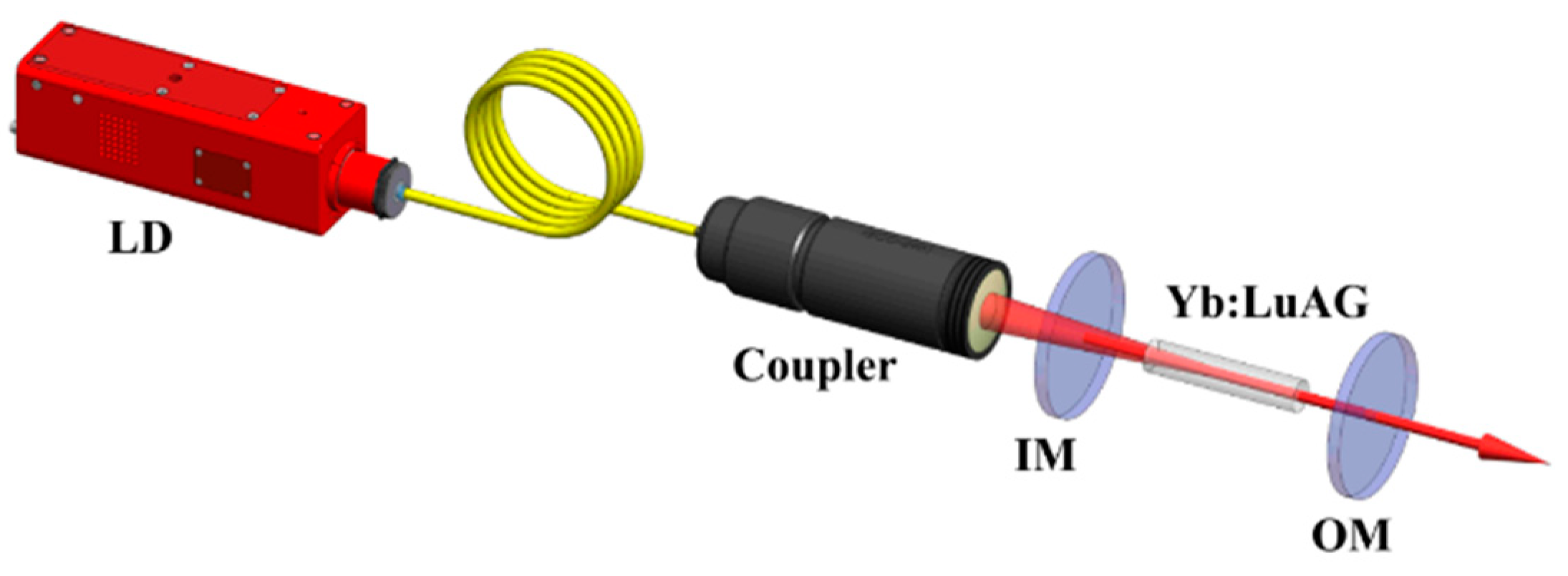
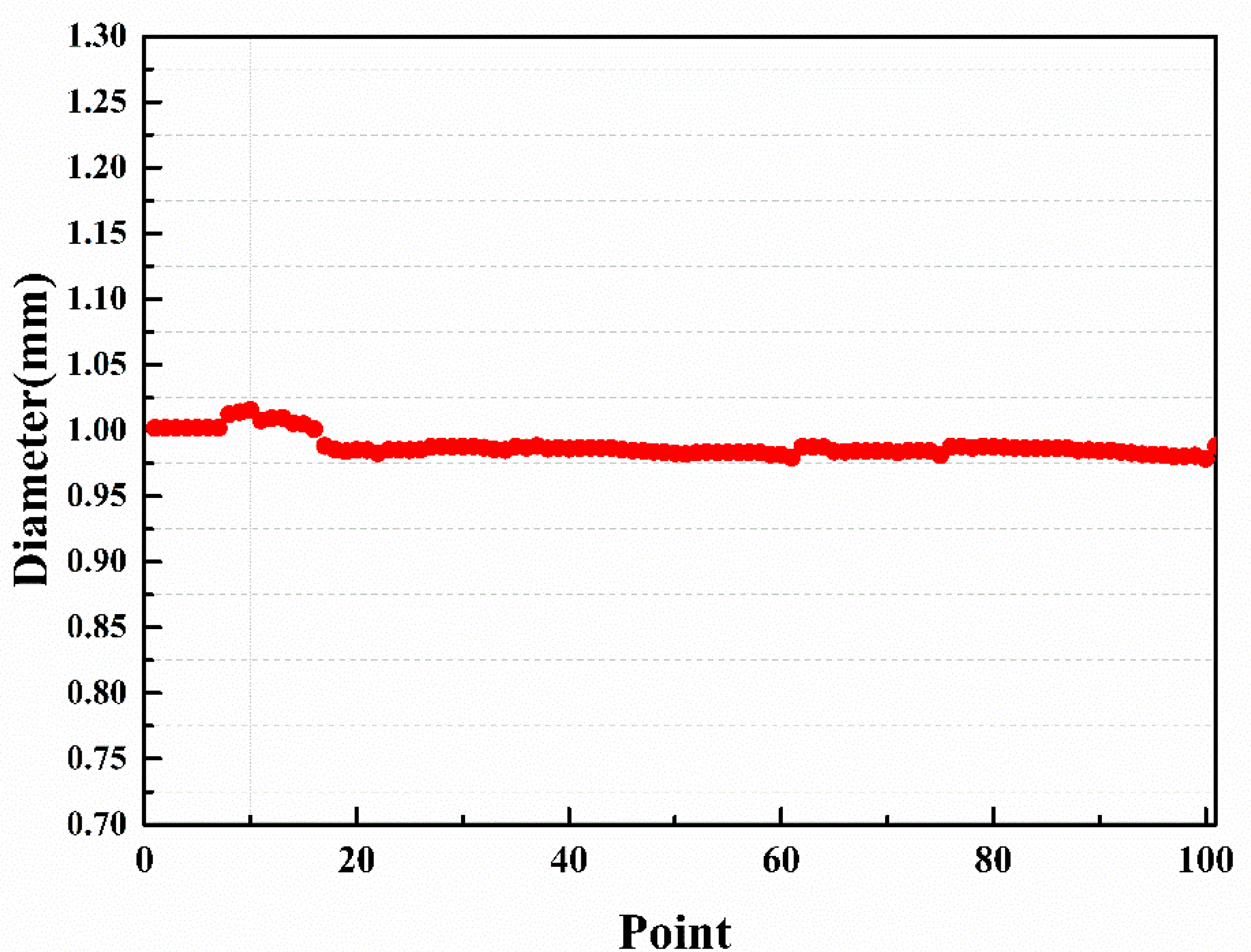
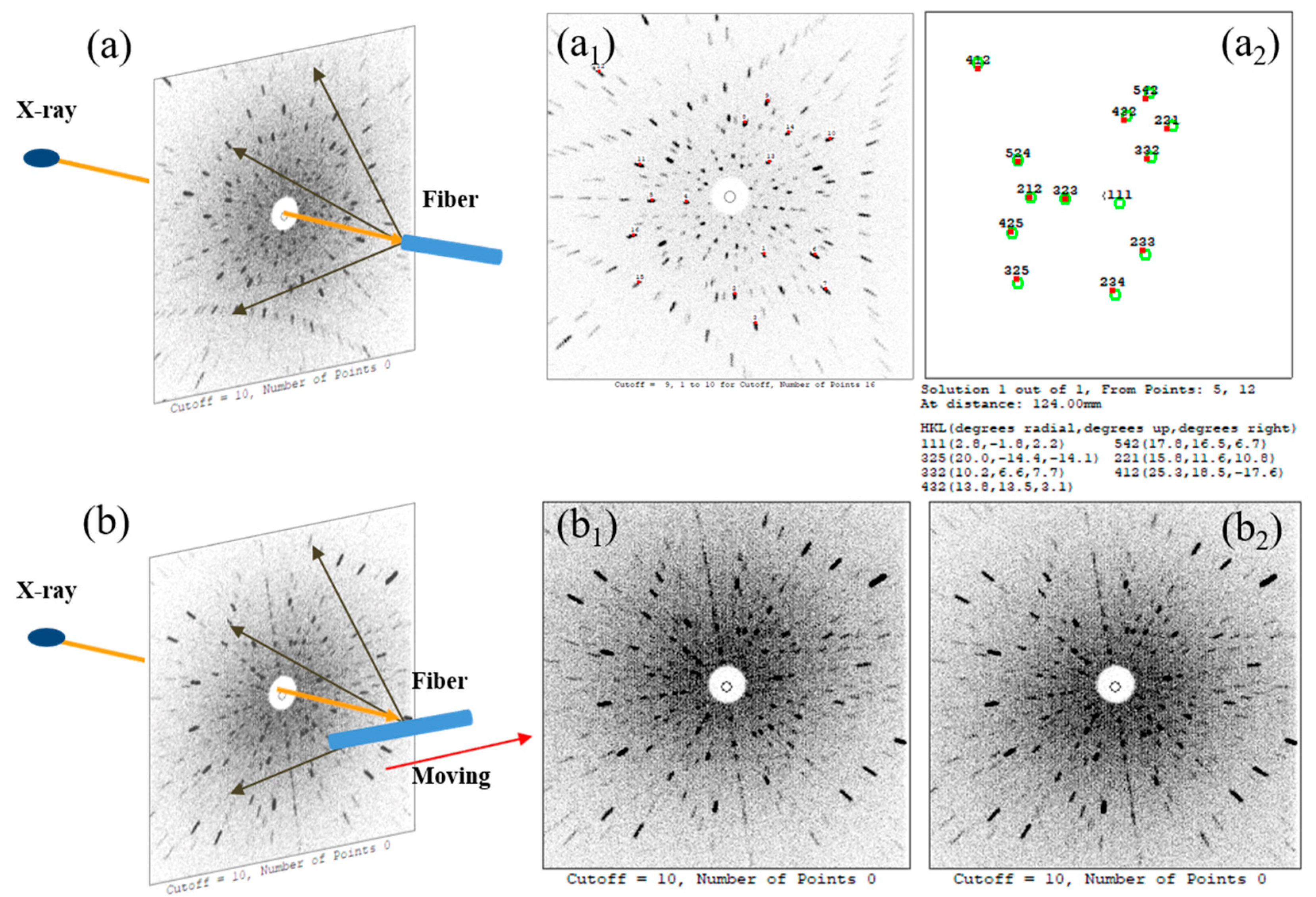


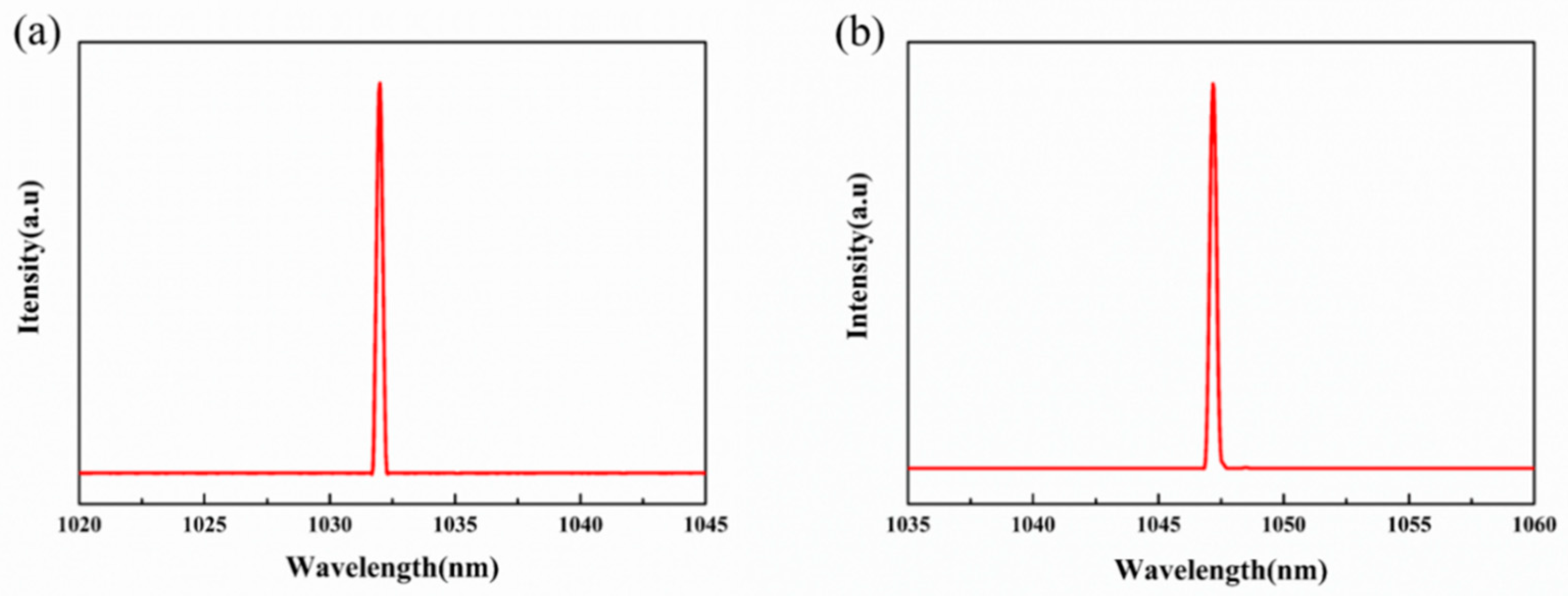
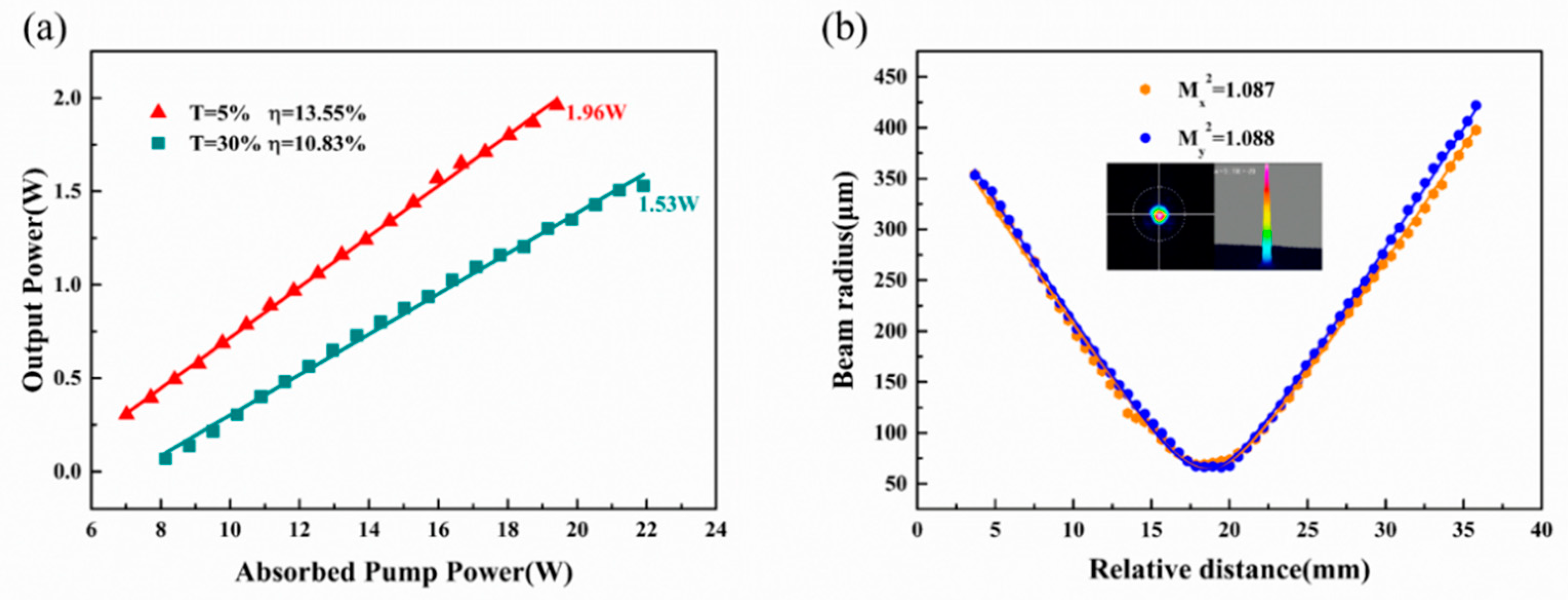
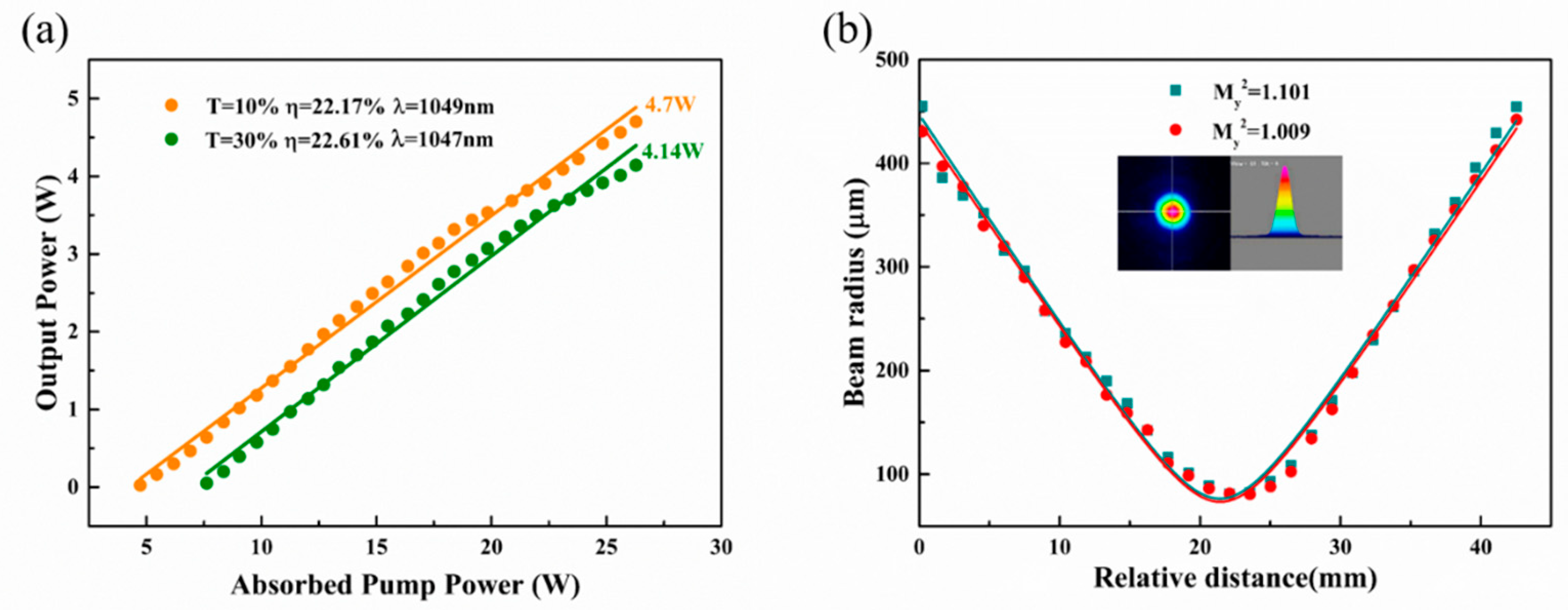
| Samples | Al (Mass%) | Lu (Mass%) | Yb (Mass%) | Yb/Lu (at%) |
|---|---|---|---|---|
| Φ1 mm Yb:LuAG SCF | 10.6 | 83.4 | 5.99 | 7.26 |
| Φ3 mm Yb:LuAG SCF | 16.6 | 75.4 | 7.99 | 10.71 |
Publisher’s Note: MDPI stays neutral with regard to jurisdictional claims in published maps and institutional affiliations. |
© 2021 by the authors. Licensee MDPI, Basel, Switzerland. This article is an open access article distributed under the terms and conditions of the Creative Commons Attribution (CC BY) license (http://creativecommons.org/licenses/by/4.0/).
Share and Cite
Wang, A.; Zhang, J.; Ye, S.; Ma, X.; Wu, B.; Wang, S.; Wang, F.; Wang, T.; Zhang, B.; Jia, Z. Optimized Growth and Laser Application of Yb:LuAG Single-Crystal Fibers by Micro-Pulling-Down Technique. Crystals 2021, 11, 78. https://doi.org/10.3390/cryst11020078
Wang A, Zhang J, Ye S, Ma X, Wu B, Wang S, Wang F, Wang T, Zhang B, Jia Z. Optimized Growth and Laser Application of Yb:LuAG Single-Crystal Fibers by Micro-Pulling-Down Technique. Crystals. 2021; 11(2):78. https://doi.org/10.3390/cryst11020078
Chicago/Turabian StyleWang, Anye, Jian Zhang, Shuai Ye, Xiaofei Ma, Baiyi Wu, Siyuan Wang, Feifei Wang, Tao Wang, Baitao Zhang, and Zhitai Jia. 2021. "Optimized Growth and Laser Application of Yb:LuAG Single-Crystal Fibers by Micro-Pulling-Down Technique" Crystals 11, no. 2: 78. https://doi.org/10.3390/cryst11020078






